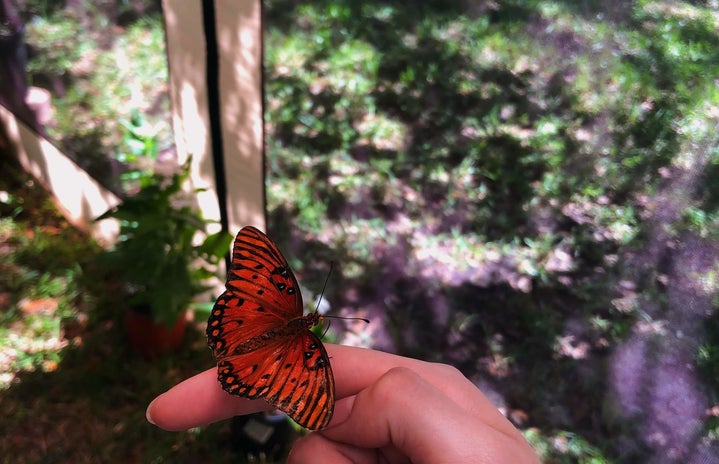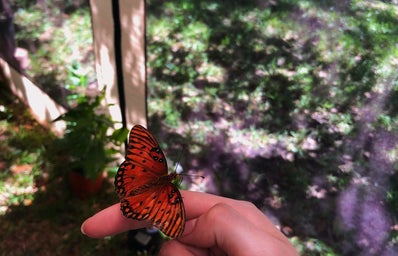We’ve all heard and watched stories based on people going back in time and changing small events that eventually lead to chaos and destruction in the present world (Harry Potter and the Cursed Child, anyone?). So have you ever wondered about the probability of these plots and if they can be classified as examples of the butterfly effect? The answer is not that simple because the theory of the butterfly effect is more complex than popular culture makes it seem.
To put it simply, the butterfly effect is the idea that small things can have non-linear impacts on a complex system. The concept was based on the semi-serious claim that a butterfly flapping its wings can cause a tornado halfway around the world. While the probability of something like that happening is low to none, it was simply meant to imply that small, nearly imperceptible changes can have massive implications in complex systems. A small event like a butterfly flapping its wings at the right time and place could, in theory, trigger a set of events that will ultimately culminate in the formation of a hurricane. These kinds of small events can thus serve as catalysts that act on starting conditions.
Although the theory of the butterfly effect has long been debated, the term is closely associated with Edward Lorenz, who developed the concept around 45 years ago. Unfortunately, popular culture has interpreted the term a little differently than how Lorenz had developed it. It has been misinterpreted as a small thing that can cause a big impact, with the implication that, like a lever, it can be manipulated to cause a desired end. Even if such leverages can be found and manipulated, the point isn’t to insert the butterfly, or the catalyst, at just the right time and place to bring about the desired outcome. What Lorenz was trying to illustrate was the idea that little insignificant events can lead to significant results over time. The idea of the butterfly effect has also paved the way for the basis of a branch of mathematics called Chaos Theory, but that’s a different topic.
As we can see from the theory of the butterfly effect, our lives can be drastically shaped by the tiniest details and events. This often makes us wonder, ‘What if?’ Although the term isn’t meant to be taken literally as a concept, here are some examples of what the butterfly theory can encompass since they involve small variances that have had profound and widely divergent effects:
1. The Cuban Missile Crisis:
It was because of one Russian Navy officer that the world was saved during the Cuban Missile Crisis. Vasili Arkhipov has often been called ‘the man who saved the world’ because of the role he played in preventing a worldwide nuclear holocaust. He was stationed on a nuclear-armed submarine near Cuba when American aircrafts and ships started sending signals to the submarine so it could be identified. The captain of the submarine had assumed that the signals meant the war had broken out since they were too deep to monitor the radio signals. He thus decided to launch a nuclear torpedo that would send nuclear clouds to hit Moscow, London, East Anglia, and Germany before wiping out half the British population. Everyone agreed except Arkhipov, who exercised his veto power and prevented what else would’ve resulted in a very different outcome.
2. The Birkin Bag:
Birkin bags produced by Hermès are the most luxurious and expensive bags in the world. But did you know that we never would’ve gotten this bag, the name at least, if the chief executive of Hermès, Jean-Louis Dumas never sat next to an actress named Jane Birkin on a plane? He got the inspiration for the bag in 1983 on a plane when the poor woman kept dropping her stuff out of her straw traveling bag. She had told him that it was difficult finding a leather bag she liked and Dumas saw that as a challenge. He named his new collection of leather bags after her and decades later, the Birkin bag is still as popular as ever, even presenting itself as a status symbol.
3. Friday the 13th:
The number thirteen has always had superstitious connotations surrounding it but it was Thomas Lawson who wrote a book called ‘Friday, the Thirteenth’ in 1907. He had used the support superstitions of the date to cause panic between stockbrokers on Wall Street and it had a great effect on the public. The US economy now loses around 900 million dollars every Friday the thirteenth because instead of going to work or shopping, people prefer to stay at home instead.
4. A KFC love story:
Hector Kansi, an erstwhile unknown South African, proposed to his girlfriend in a KFC outlet in South Africa. A man who had captured the moment decided to post the picture on Twitter and taunted him for being broke. The tweet went viral and people decided to show their love and support. KFC South Africa was also among the first to respond and they gave the couple some offers. After this, more offers came flooding in such as CastleLite offering to pay for everything for their honeymoon, Siwela Wines offering all the wine for their wedding, PUMA offering a voucher worth 700 dollars, as well as about another 30 well-known brands offering them other luxurious things.
We can’t always predict things that will happen in our lives, since the smallest events can change everything. However, what we can take away from the butterfly effect is that even though we can’t identify, predict or control every catalyst in our lives, we should always be mindful of the kind of catalysts that might act on chaotic conditions, even though that’s as far as our power exceeds.


